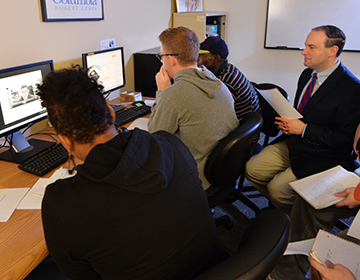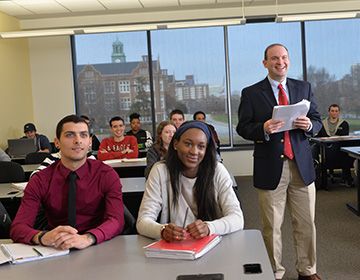Unlocking the Web
Professor Jonathan Lazar is committed to ensuring Web accessibility for all.

For millions of Americans with disabilities, Web browsing can be frustratingly difficult. Enter Jonathan Lazar, who, with his students, is smashing barriers to access—one project at a time.
Lazar, professor of computer and information sciences, directs Towson University’s undergraduate program in information systems and founded the university’s Universal Usability Laboratory. He’s one of the nation’s leading authorities on human-computer interaction, yet there’s nothing remotely “ivory tower” about his zest for making the Web accessible to all users.
“Who is locked out?” Lazar asks rhetorically before launching into a list that includes users with perceptual or motor impairments, including people who are blind, low-vision, or who have limited hearing. Also included are those with limited use of their hands or impaired speech.
A Major Quality-of-Life Issue

According to Lazar, the societal implications of being locked out are enormous. He cites as an example a job applicant who is blind and using a screen reader to access Web pages. He can’t navigate an employer’s website because it’s designed in an inaccessible manner. As a result, he’s unable to submit a resume online, so he has to call the employer, reveal his disability, and make alternate arrangements. That could make him seem less capable, when in fact he’s a good candidate.
“That’s just one case of how inaccessibility equals discrimination,” Lazar adds, noting that it’s a major quality-of-life issue for people with disabilities.
Lazar, who joined the faculty in 1999, integrates his extensive usability research with real-world projects that pinpoint accessibility problems—and offer solutions.
He points out that federal disability rights laws exist to protect people with a wide range of perceptual, motor and cognitive disabilities. However, problems abound because federal regulations and enforcement have not kept pace with the need for expanded access.
Bringing Discriminatory Practices to Light
One notable project involved having students pose as blind consumers attempting to purchase airline tickets. Unable to take advantage of Web-only fares from inaccessible websites, they called the airlines for help—and too often got higher price quotes and additional fees. Knowing that both are illegal under existing regulations, Lazar and his team brought the practices to the federal government’s attention. When the U.S. Department of Transportation issued new regulations in 2013, his research was specifically cited as justification for some of the rules.
Lazar collaborated with colleagues, graduate and undergraduate students to develop an easy-to-use audio CAPTCHA for blind users. (CAPTCHAs are tests consisting of distorted visual text or a distorted audio clip. They thwart viruses and bots by differentiating humans from computers.) Last spring the team was granted a U.S. patent for the Sounds Right™ CAPTCHA, which continues to undergo beta testing.

In addition, Lazar championed the passage of a Maryland law to increase the amount of teaching information technology accessibility concepts at the state’s public universities. He was heavily involved with the effort, testifying on behalf of the bill and present when then-Gov. Martin O’Malley signed it into law last May.
Last spring students in Lazar’s Universal Usability course (CIS 445) partnered with the Baltimore County Public Library (BCPL), investigating how to make public libraries more accessible to patrons who are blind or have low vision. Student teams evaluated the BCPL website, the physical environment at select branches, library offerings such as databases and equipment, and the library’s marketing efforts to the blind community. In addition to suggestions aimed at improving website navigation, the class identified places where Braille signs were needed (i.e., audio books) and counseled staff on how to interact with blind patrons. (The list of “don’ts” included petting service dogs or moving canes.) “The students loved applying what they’d learned, and the library administration was very receptive,” he says.
The Potential to Change the World
Lazar’s students needed more than classroom instruction to design accessible systems. As part of the class, he conducts annual field trips to the Baltimore-based National Federation of the Blind, Blind Industries and Services, and the Maryland Library for the Blind and Physically Handicapped. “I’ve seen students have epiphanies after seeing blind people learning to use table saws and gas stoves,” he notes. “Whatever preconceived notions they had about blindness get shattered there.
“I want my students to see the connection between their work and the potential to change the world. It doesn’t need to be just a job—it can be something much more meaningful.”
With his eighth book, Ensuring Digital Accessibility Through Process and Policy, slated for May 2015 publication, Lazar documents public and organizational policies that have proved effective in ensuring digital access for all users. “Our disability laws are rooted in the civil rights movement, as are the remedies. Computer scientists can have an important societal impact by designing accessible systems.
“We need to continually ask ourselves “How can we be more inclusive, more open? How do we make it happen? There’s so much we can do to ensure that no one is locked out of the Internet.”